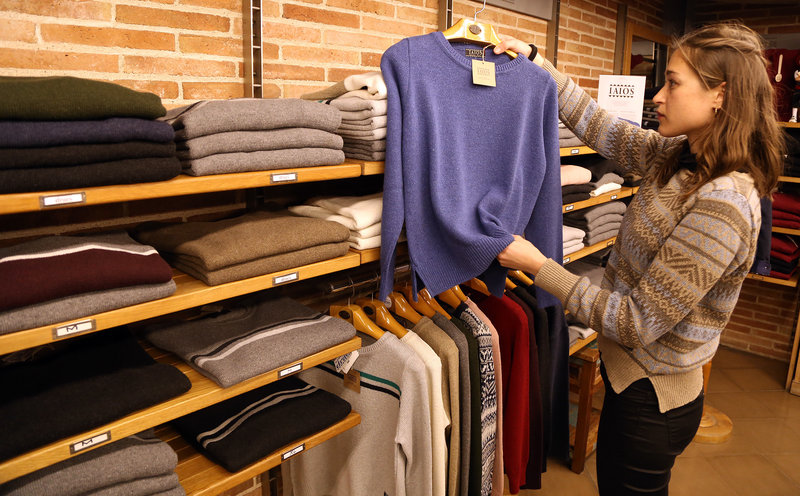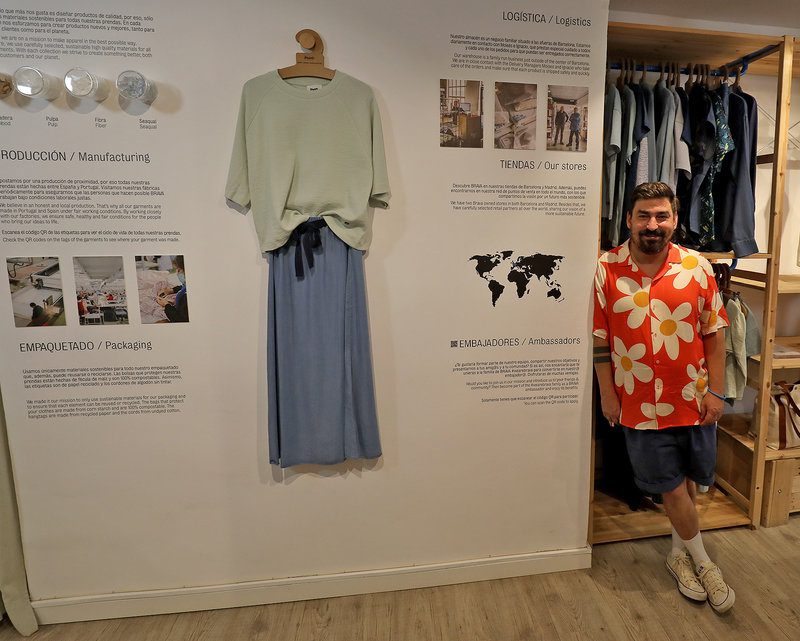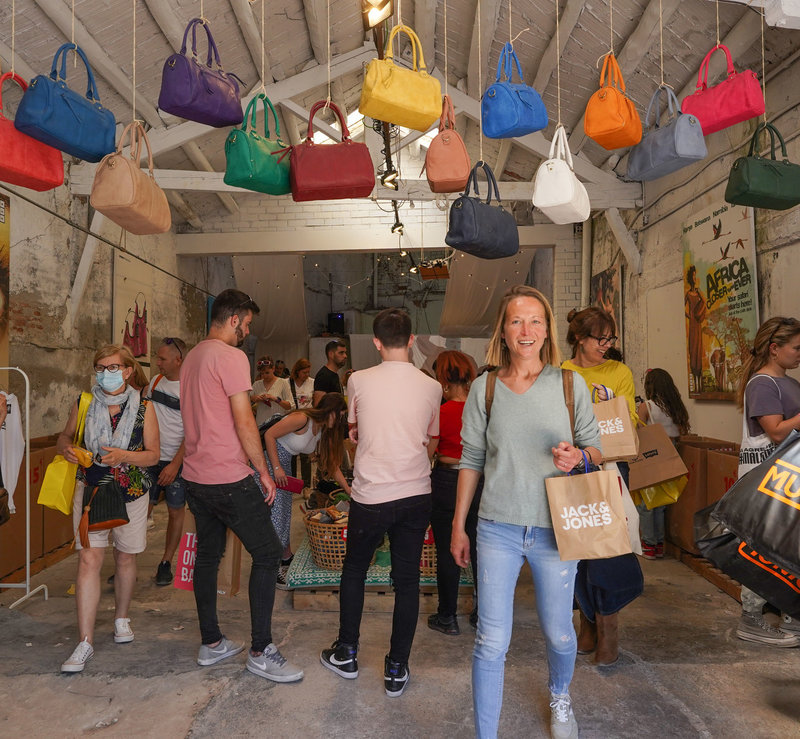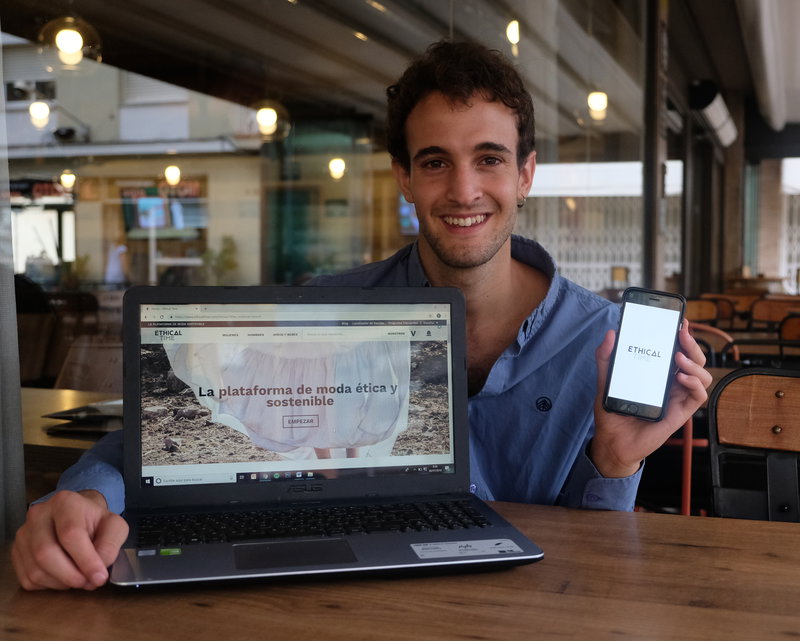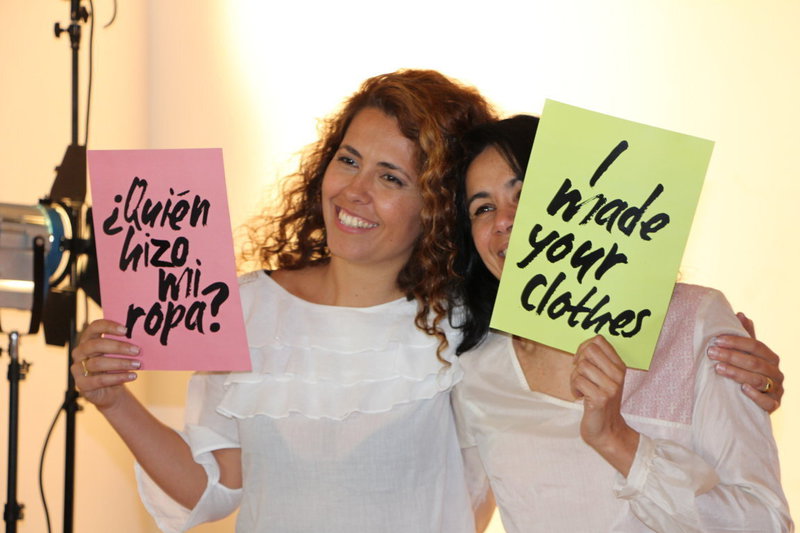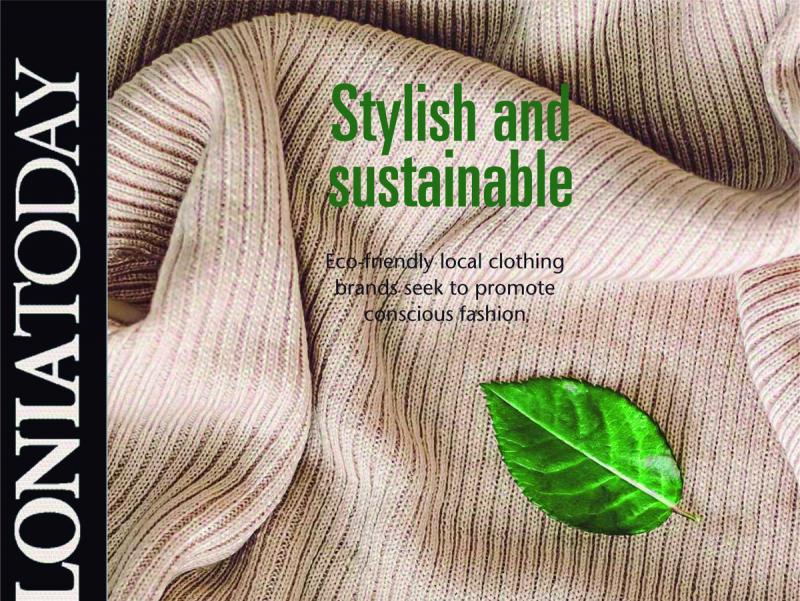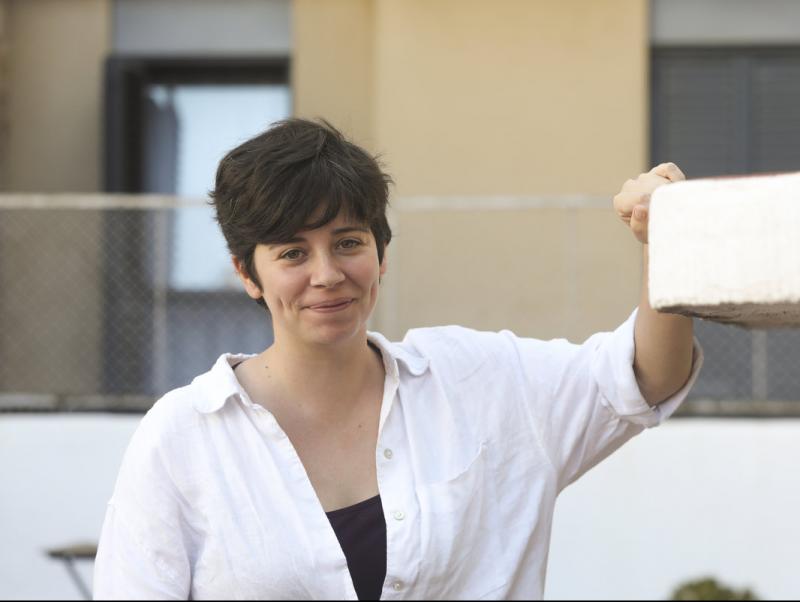Conscious fashion
There are nearly 300 sustainable clothing brands in Catalonia. The owners of these brands say that even with a growing number of committed customers, it is not easy for them to survive
“We have learned from our grandparents to make sweaters like those of yesteryear” “If clothes are good quality and you take care of them, they will last you many years”
Responsible consumption is much more widespread in northern and central Europe
To promote the sustainability and circularity of the business, they also care about making garments that last
More than 10% of greenhouse gases come from the fashion industry, the second most polluting sector on the planet. It is also among those that consume the most resources: 2,700 litres of water are needed to produce a simple cotton T-shirt. The other great drama hidden by much of the conventional textile industry is labour exploitation. According to the UN, one fifth of the clothing we consume is made using slave labour. A recent report warns that behind the success of Chinese giant Shein, so popular with many young people because a shirt can cost less than a soft drink, there are 75-hour working weeks, jobs without contracts and facilities with serious safety flaws. But while there is a fear that other companies like Shein will appear, there are also brands that are committed to environmentally-friendly materials and production processes, local manufacturing, decent and fair working conditions and the fight against the use of toxic chemicals or the waste of natural resources such as water. According to the latest data from the platform Ethical Time, there were nearly 300 sustainable clothing brands in Catalonia in 2020, 23% more than a year earlier.
One of the associations that has worked most to promote the sector in Catalonia is Moda Sostenible Barcelona (Sustainable Fashion Barcelona or MSBCN), which was founded in 2013 and has promoted initiatives such as the Sustainable Fashion Forum, of which nine editions have already been held, and the Re-Barcelona conference, an international meeting point for sustainable and ethical fashion in southern Europe. María Pérez-Hickman is its president, and although she notes that the UK is one of the most advanced countries in terms of fashion and sustainability, and that US brands such as Patagonia have also had a strong impact, “stirring consciences” in 2011 with a Black Friday campaign called “Don’t buy this jacket”, the real turning point came on 24 April, 2013: the day 1,130 people were killed when Bangladesh’s Rama Plaza textile complex collapsed. The employees, who worked for about 30 international companies, had repeatedly warned the building was in very poor condition: “This was not an accident, it was murder in broad daylight,” said lawyer and human rights defender Sultana Kamal at the time. As Pérez-Hickman explains, “the world began to realise then that the fashion industry was doing very badly, leading to the emergence of many brands with a clear sustainable positioning.”
In Catalonia, she continues, “at the moment the demand for new brands is very high”, and there are interesting initiatives such as the Pact for Circular Fashion or the training programme on sustainable textile entrepreneurship run by Barcelona Activa. However, she also considers that small entrepreneurs have a “huge need for capital to sustain their projects while creating brand loyalty”, believing that they should be helped “with initiatives that promote local consumption and support local talent, such as free sales and exhibition spaces”.
“We have learned from our grandparents to make sweaters like those of yesteryear,” claims IAIOS, a manufacturer based in Granollers that recycles leftover scraps from factories to reproduce yarn, a process that does not generate waste and avoids the dyeing process, which in addition to using large amounts of water, also pollutes. To reduce its carbon footprint, it also manufactures everything in local workshops: Olot, Sabadell, Igualada, Barcelona and Maresme. Gemma Barbany is a member of the fifth generation of this family dedicated to textiles. Her father, who owned a clothing store, created a collection with recycled yarn back in 1995, but had to stop because, she says, it was a product that “was not valued at the time”. But things changed, and they restarted the brand in 2016. “We made a small collection of three hundred sweaters, and we saw that people were much more predisposed towards them, especially young people, who are much more informed and aware.”
Clothing that lasts
Barbany joined her father and brother to redesign the brand. Although they started out making only sweaters, since that is a very seasonal product, they also now make T-shirts with certified organic cotton. The company had a turnover of 300,000 euros last year, and the forecast is to increase this by 20% this year.
To promote the sustainability and circularity of the business, at IAIOS they not only use recycled yarn, but also care about making garments that last and can, if necessary, have another life. As Barbany explains, “our sweaters don’t have buttons, zippers or other parts that would hinder the recycling process.” In addition, they are made with “basic patterns, which look good on all bodies, and are of timeless design so that they do not go out of fashion.” Now they have just launched a service to get their sweaters ready for the winter season. Barbany says that the sustainable fashion sector “is evolving rapidly”, but makes it clear that things are not easy for the small business owner, who does not have a large enough budget to compete with the big brands. “There is a lot of support in the form of mentoring or market analysis, but we need direct financial aid to be able to go to an international fair, for example,” she reflects. The other problem is the consumer’s pocket: “During lockdown, we noticed that people were more aware, but price has once again become a priority, the economic recession is noticeable.” As for the rest of the advocates of sustainable fashion, for Barbany the recipe is clear: “Buy less, but better.”
Daniela Vidort is part of the training and dissemination platform Slow Fashion Next, which brings together entrepreneurs, established brands and also students. Vidort, who has worked for many multinationals, confirms that a lot of fashion companies are undergoing a facelift, but that there are few truly sustainable companies – “much of the sector is greenwashing” – and says that this will happen until there is “legislation that forces us to do things right and then ensures that it is not breached”. However, she also notes that “people are waking up”. “The history of fashion runs parallel to that of society, and now there is great social change and fashion is looking for where to go.” The first thing to do, she believes, is to put an end to “the two-facedness of governments, which say they want to promote sustainable fashion while allowing companies as polluting as Shein to exist”.
Slow Fashion Next is made up of around 50 entrepreneurs, and Vidort talks of its united strength. “We do a lot of networking, but we also group together to make joint purchases, which is very important to ensure a minimum amount of product in the workshops... if we ask them to start up the machines for only 50 T-shirts, they don’t want to because it’s not worth it.” She also works with entrepreneurs from the Tecnocampus of Mataró and IMPO Badalona, and says that there is a noticeable dynamism, while also warning that she is tired of seeing “small brands with precious ideas having to close”.
Vidort has a sustainable clothing brand, Aconkagua. She makes regenerated and recyclable organic cotton suits and in the case of bikinis, nylon comes from recycled fishing nets. In addition, dyes do not harm the environment, and the process does not use water. “Looking for ecological dye is expensive and difficult, H&M or Decathlon sell bikinis for three euros, and the fabric alone costs me six, but I do it out of conviction. My dream is to be able to live off this someday, but in the meantime at least I’m showing that things can be done.”
Opting for design
Brava Fabrics is one of the brands that has managed to grow the most. It was founded in 2015 in Barcelona by Ramón Barbero and Iván Monells. The two met at the ESADE business school and immediately saw that they shared not only an entrepreneurial spirit but also concern for the environment and social responsibility. They decided to create an ethical and sustainable clothing brand, but with a clear premise: they would not compromise on design. “Many sustainable fashion brands opt for minimalist basics; we bet on design,” says Monells.
They started making men’s shirts and today have 27 product categories for both men and women. They mostly manufacture in Portugal due to the volumes they move (more than 20,000 pieces of clothing a year). Responsible consumption is much more widespread in northern and central Europe, Monells and Barbero explain. “If you don’t have an ecological certificate, multi-brand stores won’t accept you, and consumers are much more informed and aware; they look at labels and even ask you technical questions. They are a decade ahead of the south of Europe,” says Monells.
Barbero reflects that it obviously has something to do with purchasing power but that it’s also a matter of commitment and consumption habits: “In Spain, France or Italy, you buy a lot of clothes; in Germany you buy fewer but of better quality.”
The founders of Brava Fabrics believe that to boost the sector there needs to be more “reflection” and “respect towards materials and manufacturing”. “The problem,” says Barbero, “is that you wear clothes only once or, even worse, you wash a wool sweater in the washing machine at 50 degrees because you didn’t check how it should be handled. Clothes must be taken care of because if they are good quality and you take care of them they will last you many years.”
Brava Fabrics continuously asks its suppliers to rethink components and processes to improve. For example, they have introduced buttons made from ivory palm, the seeds of which are used to make various elements. The traceability of the entire process is documented on the group’s website , and the company has an agreement with two NGOs to offset its ecological footprint by planting trees and collecting plastic from the oceans. Last year, Brava Fabrics had a net turnover of 3.6 million euros and this year’s forecast is 4.8 million.
“We don’t generate waste, we eliminate it by giving a second life to what’s no longer in use,” say biologist Montse Bayen and environmentalist Núria Nubiola, founders of Infinit Denim, a brand of clothing, handbags and accessories based on the principle of the circular economy. Bayen explains that the two started working together to raise awareness and then thought about how they could recycle waste. It was Bayen’s mother who led the way. One day she made a handbag with denim and they “saw the light”. Shortly after, in 2019, Infinit Denim was born, which today has a turnover of 180,000 euros.
The denim comes from used or unsold jeans, and they also use recycled pre-consumer cotton and cellulose from sustainably grown forests. They have now taken things a step further with the release of their first model of jeans made with their own denim fabric. All the clothing is made in their workshop in Barcelona and others nearby. The founders of Infinit Denim believe that in order to be truly sustainable, the entire process must be thought through, starting with the design of the product: “It’s very basic, but to be able to recycle a garment it’s very important that it’s made of a single material; for example, the buttons we put on our jeans are screwed on, making them much easier to remove when the garment has to be recycled.”
The brand has a government grant to innovate in the circular economy, but Bayen believes there should be much more support, such as a reduction in VAT, “which would help commercialisation”. “Not everyone can afford a 120-euro pair of jeans, the power lies with the consumer, but a family with three children has to dress them all and it’s not easy,” she reflects.
feature Sustainable fashion
feature Sustainable fashion
feature Sustainable fashion
Help to grow brands and give them visibility
Together with digital transformation and internationalisation, circularity and sustainability are the main challenges facing the fashion sector today,” says Agnès Russiñol, director of the Consorci de Comerç, Artesania i Moda de Catalunya (CCAM). That is why, she explains, the government has promoted the Circular Fashion Pact, a voluntary agreement between institutions and companies that aims to facilitate the incorporation of sustainability and recycling measures, the promotion of collaborative projects and the competitiveness of the textile sector. Since this year, there is also a line of specific aid for companies that incorporate sustainable processes, tools and materials that improve the degree of circularity of their products, as well as the recovery and recycling of waste generated. The initial budget for this line of aid – which can be extended – is 175,000 euros.
Russiñol acknowledges that the economic crisis and the rise in raw material prices “do not help” the sector, but she is convinced that “sustainability was perceived a few years ago as an added value of brands, but that with the current climate emergency it is clear that it has now become an obligation”, which is favouring the transformation of the textile industry. “Consumers are calling for change, and what we have to do is a lot of educating about why we need it and everything it involves, while also helping firms promote themselves.”
To give visibility to brands, the seventh edition of Rec.0/080 Barcelona Fashion has just been held, a contest that seeks out the best emerging proposals for sustainable and local fashion. The prize consists of a free marketing and promotion space in the REC’s new sustainable fashion space, Europe’s largest festival of pop-up fashion stores (temporary stores), held in Igualada each year.
“40% of the brands that started with us have disappeared”
At the age of 17, he decided that he would not buy the products of any brand that exploited its workers. Eiriz went to Bangladesh to see where and under what conditions our clothes were manufactured, studying the operation and impacts of the textile industry, and ending up an expert in sustainable alternatives. “Through Facebook or WhatsApp groups, people were increasingly asking me where I was buying, and I decided to do something to give visibility to brands and bring supply and demand together.” At 24, he is now CEO of Ethical Time, a platform that aims to bring consumers closer to “really” sustainable clothing brands. The nuance is important: “The sector is full of companies that say they are sustainable, but few generate real change,” says Eiriz, who studied advertising at Pompeu Fabra University.
This entrepreneur has created the Real Sustainable Fashion seal, which evaluates the determining factors in how a brand creates all of its garments, including suppliers, certificates, fabrics, transport and place of manufacture. The seal ensures, for example, that workers throughout the supply and production chain have a decent and safe job, thanks to which they achieve “a better quality of life”. To avoid greenwashing (brands that sell practices as ethical and responsible when they are not), it also evaluates “the use of resources and waste, as well as the brand’s commitment to minimising and compensating for its impact on the environment”.
Obviously, the seal verifies companies’ social and environmental practices, but also whether their entire model is consistent with what they preach. It therefore looks at its model of communication, transparency and public disclosure in great detail: “We evaluate, for example, whether its communication is based only on selling more or if it promotes more responsible forms of consumption, giving advice on how to take care of a sweater so that it lasts longer or giving the option of wearing it when you no longer want to, so as to reuse the thread”, Eiriz states.
For this CEO, right now we are at a time of “change and great opportunities” for the sustainable fashion sector, because “there are a lot of people who examine the labels and wonder what’s behind what they buy”. “The issue is whether big brands will also dominate the new model,” he reflects. As he points out, the European Union has committed to legislating what is meant by sustainable fashion to bring an end to greenwashing, but the problem, he warns, is that it could easily turn into a “minimum requirement”, because large multinationals and lobbyists are pushing against it. In fact, Eiriz says, there are even universities and fashion schools that, when teaching students about alternatives, only show the small H&M or Inditex collections made with organic cotton and not the large number of products promoted by truly sustainable SMEs.
For the latter, the path is not easy. As Eiriz sums up: “Entrepreneurship is difficult in our country because the costs of being self-employed are high, and in sustainable fashion the expenses are higher than those of a traditional brand, so the risk of failure increases.” One fact says it all: “40% of the brands that started with our platform have disappeared.”
Ethical Time won the Eco-National Award for the Best Digital Initiative in 2019 and has the support of other entities. The Real Sustainable Fashion certificate has been designed with the support of an advisory group made up of people with extensive experience in the world of sustainability and the impacts of the fashion industry. Verification is reviewed periodically.
How to be a “fashion revolutionary”
Becoming a fashion revolutionary can be as simple as changing the way you buy, wear and throw away your clothes,” says the Fashion Revolution, a platform working for sustainable fashion. The platform does talks and courses and produces material to promote a change in the model of production and consumption. Here are their commandments to drive change.
MEDITATE
DOWNLOAD AN APP
Applications such as Good Guide, Ethical Barcode and Buycott allow you to scan the barcode of a piece of clothing and find out its social and environmental impact.
INVESTIGATE
Do research. There are thousands of young designers working sustainably waiting to be discovered.
CHOOSE SECOND HAND
There are second-hand shops that even have last season’s collections. You can prevent clothes in perfect condition from ending up in the bin.
SWAP
BE IMAGINATIVE
If you don’t like a piece of clothing, give it new life by dyeing it or turning it into something completely new, like a scarf or a handbag.
REPAIR IT
TRY IT YOURSELF
Why don’t you make your own clothes? You may have to learn to sew, but a whole world of possibilities opens up…
ORGANISE ACTIVITIES
DIVE IN

